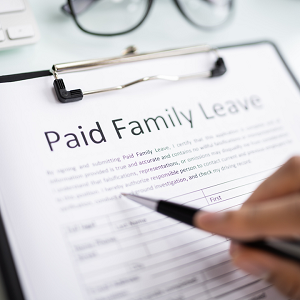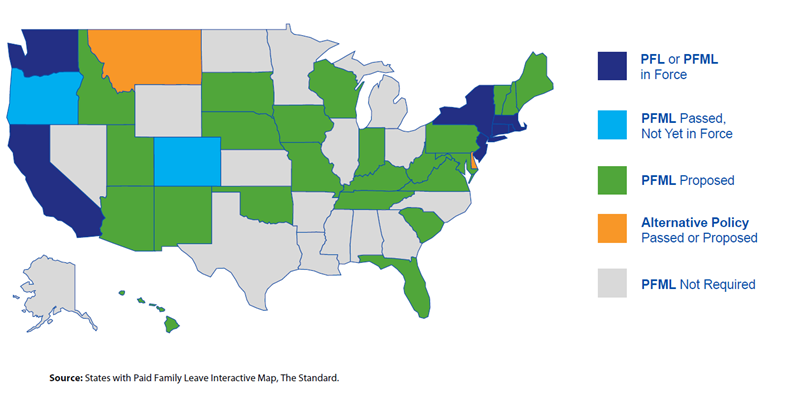Adding “Paid” to the Statutory Family Leave Equation at Breakneck Speed
 By Terri L. Rhodes, CCMP, CLMS, CPDM, MBA, CEO, DMEC
By Terri L. Rhodes, CCMP, CLMS, CPDM, MBA, CEO, DMEC
Perspective is a powerful thing. Employee needs (and expectations) have changed a lot since 1993 when those working for companies with more than 50 people received the federally protected right to take unpaid, job-protected leave for specified family and medical reasons under the Family and Medical Leave Act (FMLA). However, since employees rely on paychecks for survival, it is still difficult for most people to take that unpaid leave.
Fast-forward to today, and we see clear demand and momentum for passing paid family leave (PFL) and paid family and medical leave (PFML) laws in states, cities, and some counties. More than 30 states have passed bills relating to PFL and PFML1 in some way, shape, or form; 10 states have enacted programs; and three have passed laws that are not yet effective. Delaware was the latest with the governor signing a PFML law on May 10.2
These laws have come at a fast clip, and we don’t expect that momentum to slow. The 2021 DMEC Paid Family and Medical Leave Pulse Survey3 showed that 81% of employers do business in states with statutory PFML laws and 73% believe PFML should be an employee benefit. For context, 34% of employers offer PFL and less than 30% of American workers have access to it.4
Practical Realities
In addition to statutory PFML leaves, integrated absence management (IAM) professionals must consider state FMLA, whether a leave request qualifies for coverage under the Americans with Disabilities Act, and if or how employer-sponsored leaves work in tandem. And while no one can rule out a federal PFML law (though it seems increasingly unlikely it will be any time soon), we don’t expect it to override state legislation, which could make things even more complicated if and when it happens.
In addition to monitoring and communicating statutory PFL and PFML leaves (as well as differences between programs for employers that operate in multiple states), IAM professionals must consider equity and fairness (perceived and real) across employee populations. The relatively new patchwork of laws creates unintentional disparities in the amount of pay, eligibility, definition of family members, and length of leave just to name a few. We heard about inherent inequities during the 2022 DMEC FMLA/ADA Employer Compliance Conference, and speakers noted that one in five employees experiences a benefits shortfall.
Paid Leave Law Map

To prevent that issue, IAM professionals should assess the fair and equitable nature of leave programs for all employees — salaried and hourly — and consider how information is communicated to set the stage for successful conversations.
Transparency is key here. In 2021, 40% of respondents to the DMEC pulse survey3 said new PFML laws had raised equity concerns though they hadn’t heard specific complaints. It’s important to get out in front of this issue before it affects employee morale and leads to resignations.
Employers must also consider how PFL and PFML complement short-term disability (STD) and other leaves that can run concurrently. Some insurance carriers are combining STD, which doesn’t have a family component, with PFL to provide a competitive edge to employers in an increasingly competitive employment market.
We discussed these issues and others with Regina Stringer, director, Integrated Absence Management, Walmart; and Jessica Bolar, product manager, The Standard; during the “Employers See Opportunities Amid Waves of PFL and PFML” episode of Absence Management Perspectives: A DMEC Podcast.5
A Holistic Perspective
Regardless of where an employer is based, where employees work, and the number of leaves (statutory and company sponsored) available, employers should take a holistic view to identify and address inherent inequities. It’s an opportunity to think strategically about how leaves affect company policies, resources, and practices and how they align with company culture.
Employers that operate in multiple states need to recognize differences in statutory PFL and PFML laws (such as how contributions and pay differ, definitions of family members, and eligibility), whether employees have access to STD, and the list continues.
These elements of leave programs affect what employees receive and can represent inequities, which is why industry experts like Bolar encourage employers to reassess benefits programs to ensure they align with cultural goals.
“You want to reevaluate and explore how benefits support and align with the mission and vision” so benefits match an organization’s cultural goals, she explained during the podcast.
Ways employers structure and communicate leave offerings can help retain and recruit employees, and when you consider the cost of recruitment, there is a business case for being generous. For context, 10% of respondents to the DMEC pulse survey3 said their PFML program was more robust than state programs; 42% have a hybrid approach and offer a richer benefit than required; and others meet the threshold.
How does your program stack up?
Employers are developing family friendly, non-statutory, paid leaves such as parental leave, which is increasingly common. Some employers offer one to three months, and a portion of that time is paid at 100% of an employee’s salary. Stringer shared information about Walmart’s paid parental leave, which was recently increased to six weeks and is used almost equally by both parents.
Some employers are also expanding benefits to include fertility and menopause leave to ensure equity across life stages and interests.
It’s exciting to see IAM professionals redefine and expand traditional leave benefit packages to ensure employees have the time and resources they need to care for themselves and their families. As one compliance conference speaker said, “Employees want to thrive; not just survive,” and they expect employers to help them do so.
Across the board, employees are looking for companies that demonstrate a commitment to family friendly work environments and non-statutory PFL can help employers take the guesswork out of the equation.
And in addition to recruitment and retention benefits, PFL offers economic benefits as noted recently by the Joint Economic Committee for the U.S. Congress, including improved business productivity and economic growth.6
All in all, this will be an exciting trend to watch.
References
- National Conference of State Legislatures. State Family and Medical Leave Laws. April 29, 2022. Retrieved from org/research/labor-and-employment/state-family-and-medical-leave-laws.aspx
- Legislative Updates. Retrieved from http://dmec.org/resources/legislative-updates/
- 2021 DMEC Paid Family and Medical Leave Pulse Survey. Retrieved from http://dmec.org/2021/09/14/2021-dmec-paid-family-medical-leave-pulse-survey-results/
- S. Bureau of Labor Statistics. Employee Benefits Survey. What Data Does the BLS Publish on Family Leave? Retrieved from https://bit.ly/3xCMecH
- Employers See Opportunities Amid Waves of PFL and PFML Laws. Absence Management Perspectives: A DMEC Podcast. Retrieved from www.dmec.org/podcast
- Joint Economic Committee U.S. Congress. The Economic Benefits of Paid Leave: Fact Sheet. Retrieved from https://www.jec.senate.gov/public/_cache/files/646d2340-dcd4-4614-ada9-be5b1c3f445c/jec-fact-sheet—economic-benefits-of-paid-leave.pdf
Related DMEC Resources
- 2021 DMEC Employer Leave Management Survey White Paper
- State-by-State Paid Family and Medical Leave Legislation: An Employer’s Guide
- Webinar Recording: Ready, Set, Go! The Evolution of PFML Preparedness
- Webinar Recording: Paid Sick Leave vs. Paid Medical Leave — Back to Basics
- Webinar Recording: Statutory Paid Leaves: What You Need to Know for 2022



